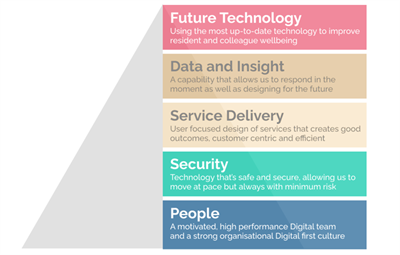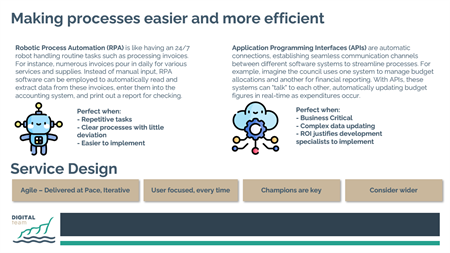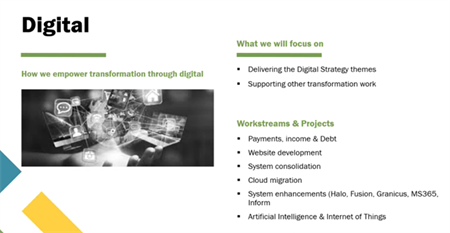Staffnet+ >
Harnessing technology and redesigning processes

Harnessing technology and redesigning processes – Nickki Johns explains the role of digital in the Reshaping Programme.
10 July 2024
DIGITAL Innovation will play an important role as the Council embarks on its latest Reshaping Programme to deliver the new Corporate Plan.
Recently, Chief Executive Rob Thomas and Director of Corporate Resources Tom Bowring set out the future for the Council as we head towards 2030 and beyond.
The new Corporate Plan describes how the organisation will look in five years’ time, while the Reshaping Programme sets out how that will be achieved.
Covering five broad themes - The Target Operating Model, Service Transformation, Strengthening Communities, Economic Resilience and Digital Innovation - the Reshaping Programme is a way of reinventing and re-examining services to best deliver for Vale communities.
Head of Digital Nickki Johns is responsible for the last of those areas as the Council looks to maximise new technologies and redesign processes to ensure services and interactions with residents are as efficient as possible.
 “We want an environment where colleagues can bring the best of themselves,” said Nickki.
“We want an environment where colleagues can bring the best of themselves,” said Nickki.
“There’s a phrase ‘digital helps us to do more with less’. There’s a risk this can be seen as demoralising because it sounds like ‘work harder and we’ll give you less support’.
“In reality, what I want technology to do is allow our colleagues to be more human, to remove the drudgery, to remove the administration and to allow us to bring our empathetic value-led selves to our work.
“We’ve invested heavily in 365 – we have one of the best Microsoft environments in Wales, it’s very rare to have E5 licences, which allow staff to access all of the platform’s functions, like we do.
“We’ve done that so we can use the tools to create a hybrid working environment that really works.”
Over the next year, the Digital Team is also looking to harness the capabilities of other software, including Power BI, Power Automate and Power Platform.
These tools help to process data faster and more effectively, meaning a series of repetitive tasks can be completed with a single touch of a button.

There are also plans to move Staffnet to a different platform and completely rebuild the external Council website.
“Workflow functions can make multiple things happen based on our actions. For example, when a form is sent out it could add information to lists, email a summary and collate the data into dashboards. without a person having to do anything,” said Nickki.
“We’re looking at the joiners, movers, leavers process. We want to get to a stage where, once someone adds a new starter to Oracle, it orders their ID badges, gets them the right PC with the right applications and software without anybody having to do anything.
“By harnessing the IT Team’s work with technology such as Autopilot and InTune, we want our colleagues to be able to pick up a loan laptop and have it work immediately. We want to take away the administration.
“That’s more efficient for us as an IT Team but the real win is a better experience for our colleagues.”
As far as residents are concerned, the ambition is not for them to access all services online.
It is about improving the website experience so those that want to can perform a particular task quickly and effectively.
Then phone conversations can focus on making sure an individual who contacts the Council in that way gets everything they need.
“The idea with the website is to again be really focused on user needs. At the moment, we’re quite transactional, but what we want to do is use some private sector technology.
“So, for instance, if you go on Amazon and buy something, it might say ‘you might also need…’ If you apply that to a resident environment, you might say ‘I’ve recently moved to the Vale’ and it shows you the five or six things you need to do: set up your bins, add yourself to the electoral role or whatever. It’s the idea of using data more intelligently, with more of a focus on resident needs so we can be predictive there as well.

“But we are not trying to push everyone online. There are sections of our population that are still very digitally excluded.
“It’s about ensuring customers have a channel of their choice and where they choose digital, that it’s incredibly easy to use.
“Say, for example, you want a green waste subscription, we want our digital experience to be so simple that an online form is the best method for the vast majority.
“That will allow us to focus on value-driven conversations. If someone falls over and needs their bins collected from the door, we can not only resolve this but arrange other services. We can use our developing Wellbeing Matters collaboration with Health to intervene early and get them the right support. It’s about the right channel for the right outcome.
“Conversations through the call centre allow us to understand more and direct people to organised services for our customers and that happens all of the time.”
There are a number of significant digital projects underway, all aimed at driving forward Council performance.
One will help support social services colleagues with data recording by allowing residents better access to the system.
They can then update personal information and be more part of the decision-making process.
“We’re also working on a digital system for housing repairs,” said Nickki. “Again, the first focus is to get our existing system working well, the second is to change the experience for our end users, our residents.
“We want a customer to be able to go online, book a repair and track their tradesman, all without needing to call us.
“It will also change the housing bids capability, so that someone will only be able to apply for housing that’s relevant for them, and hugely automate that process for colleagues and residents.
“There will be a significant uplift to our resident experience there.
“We’re also going to support our colleagues in Social Care. At the moment, when a customer wants to sign up to telecare, they have to fill in heaps and heaps of forms. We want to do that digitally and take the payment online as well.”
The emergence of Artificial Intelligence (AI) has been a significant development for digital innovation in recent years.
This allows a computer to perform tasks that previously had to be carried out by humans as they involve particular processes, such as the ability to reason.
The scope and potential of AI is broad so it could benefit the Council in a variety of different ways.
“We see AI as being a massively significant tool. We need to make sure we’ve got data in the right place with the right permissions so AI is as effective as possible. We want to embrace it but do it carefully,” said Nickki.
“On a low level, AI can be used to not just transcribe, but to summarise meeting notes. Some of the tools are really good at this so you no longer have to take meeting notes, which allows you to have a freer conversation.
“At the far end, the most powerful use of AI is about helping us understand significant data sets and tracking and highlighting trends or points of interest that would help us be more predictive in what we do.
“There is certainly something useful about predicting trends in behaviour, say in a school, that could help us be where we need to be to intervene better, although that’s a long way down the track.
“What’s critical is that we get our foundations right to ensure that once we implement this technology, our data is clean and well organised. We’ll need to work with our colleagues across the organisation to get these key foundations in place and then once we do, we intend to be a leading authority in its use”
All this may sound daunting and a significant departure from how colleagues are used to operating.
But it is important to remember that the overriding objective is for digital to simplify tasks and make people’s working lives better.
“Digital isn’t just about new technology, it’s about service redesign,” added Nickki.
“That means really focusing in on the needs of our staff or residents and working with them to create better processes that are smarter and improve how we operate.”
Over the coming weeks, other members of SLT will introduce the remaining four reshaping themes and all staff are encouraged to share their views as the Corporate Plan develops.